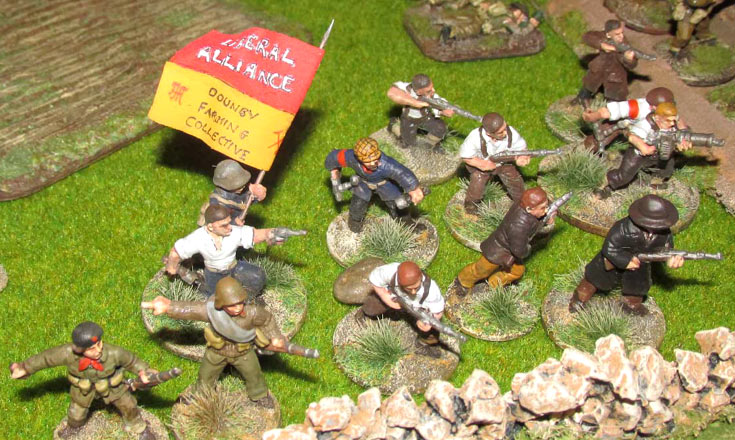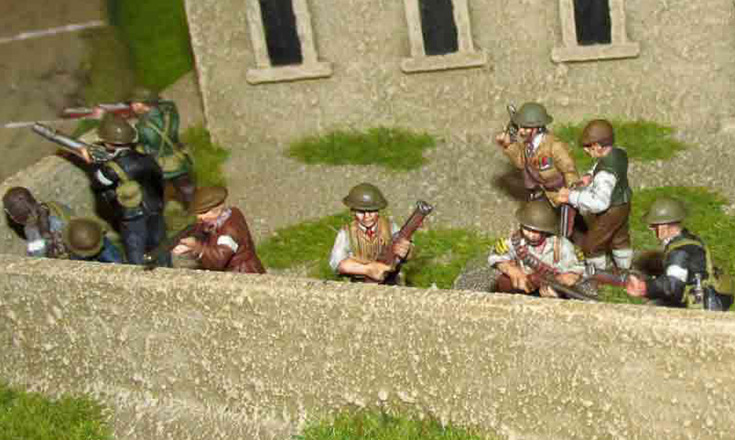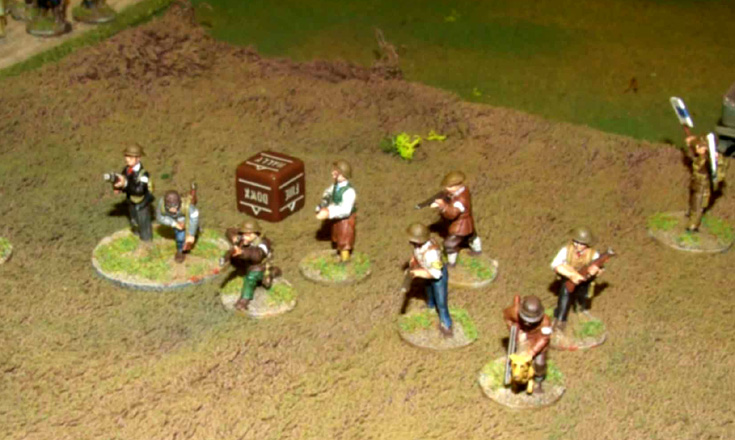
The Dounby Road, 1937
15th May 2014, 0 Comments
A Very British Civil War, Chain of Command, 28mm
We haven’t played a Very British Civil War game for more than a year, so we decided it was time for another outing. This time though, we decided to try them with Chain of Command, or preferred Second World War skirmish rules. In fact the rules needed very little adapting – we hit a problem with the use of 1930’s armoured cars, anti-tank rifles and machine guns, but we invented out own stats, and everything worked smoothly. Since then we’ve found all our questions were answered on various CoC fora. The game was an encounter between the Edwardian forces of reaction, and the Albertine forces of progress, set somewhere in Orkney somewhere between Finstown and Dounby. In our VBCW Orkney campaign Dounby is a stronghold of the left (dominated by the Dounby Farmers’ Collective), while Finstown lay within reach of the right-wingers based in the main town of Kirkwall. A motorised column of Edwardians headed up the Dounby road, after hearing that the defences to the south of Dounby had been abandoned by their naval defenders, who were in the village’s Smithfield Arms, celebrating Trafalgar Day. Unfortunately as the Edwardian column passed through Finstown they were spotted by a “roadwatcher”, and a call was placed to the front bar of the Smithfield. The half-drunk matelots spilled out of the bar and headed down the road, accompanied by a section of Royal Marines, and members of the Dounby Farmers’ Collective. The Edwardian column consisted of a platoon of the Orkney Territorial Army, a mixed bag of Orkney Constabulary, Police Paramilitaries (the Dark Islanders), a squad of local landowners and an antiquated Rolls Royce armoured car called the Earl Sigurd. The game began as both forces first made contact with each other on the Dounby Road. In CoC you begin with a “patrol phase”, where markers are moved forward to within a foot of the enemy. This ended with the Albertines back in their old entrenchments, and the Edwardians facing them just beyond Bimbister Farm, with a “jump off point” off on the left flank, behind a small patch of hilly moorland called Stoney Hill.
Unfortunately as the Edwardian column passed through Finstown they were spotted by a “roadwatcher”, and a call was placed to the front bar of the Smithfield. The half-drunk matelots spilled out of the bar and headed down the road, accompanied by a section of Royal Marines, and members of the Dounby Farmers’ Collective. The Edwardian column consisted of a platoon of the Orkney Territorial Army, a mixed bag of Orkney Constabulary, Police Paramilitaries (the Dark Islanders), a squad of local landowners and an antiquated Rolls Royce armoured car called the Earl Sigurd. The game began as both forces first made contact with each other on the Dounby Road. In CoC you begin with a “patrol phase”, where markers are moved forward to within a foot of the enemy. This ended with the Albertines back in their old entrenchments, and the Edwardians facing them just beyond Bimbister Farm, with a “jump off point” off on the left flank, behind a small patch of hilly moorland called Stoney Hill. The game began with both sides deploying around their “jump off points”. The Edwardians put their police and paramilitaries in a wheat field to the right of the road, supported by half of the territorials and a machine gun. It went in a forwards machine gun emplacement abandoned by the Albertines. The rest of their force deployed behind Stoney Hill, including the very brave commander of the Earl Sigurd, who picked his way across the moorland towards the Russland road which lay beyond it.
The game began with both sides deploying around their “jump off points”. The Edwardians put their police and paramilitaries in a wheat field to the right of the road, supported by half of the territorials and a machine gun. It went in a forwards machine gun emplacement abandoned by the Albertines. The rest of their force deployed behind Stoney Hill, including the very brave commander of the Earl Sigurd, who picked his way across the moorland towards the Russland road which lay beyond it. On the Albertine side the sailors deployed in the earthworks on the small hill on their left, and behind the smaller wheat field at the junction of the Dounby and Russland roads. The Royal Marines held the earthworks on their right, backed up by a Universal Carrier, equipped with a Boyes anti-tank rifle.
On the Albertine side the sailors deployed in the earthworks on the small hill on their left, and behind the smaller wheat field at the junction of the Dounby and Russland roads. The Royal Marines held the earthworks on their right, backed up by a Universal Carrier, equipped with a Boyes anti-tank rifle. The Dark Islanders led the advance, but came under a heavy fire from the small hill on their right. They were pinned down, and soon the marines and sailors joined in, backed up by a 2-inch mortar. The police tried to move forward to help them but they were pinned down as soon as they left the wheat field. Eventually the Dark Island squad took so many casualties and shock markers that it became pinned. Two more phases of pounding and they broke and ran. That pretty much stymied the Edwardian’s advance up the road. Still, there was still the left hook around the back of Stoney Hill…
The Dark Islanders led the advance, but came under a heavy fire from the small hill on their right. They were pinned down, and soon the marines and sailors joined in, backed up by a 2-inch mortar. The police tried to move forward to help them but they were pinned down as soon as they left the wheat field. Eventually the Dark Island squad took so many casualties and shock markers that it became pinned. Two more phases of pounding and they broke and ran. That pretty much stymied the Edwardian’s advance up the road. Still, there was still the left hook around the back of Stoney Hill… Over there the gentlemen landowners and farmers were targeted by the Dounby Farmers’ Collective – a bit of a social grudge match – and soon the landowner section began taking heavy casualties. Still, Earl Sigurd came to the rescue, as did a truck filled with territorials. It though, was shot up by a Royal Marine Bren gun and rifles, and was set on fire. The part-time soldiers spilled out of the back, but were pinned down by enemy fire from the far side of the Russland Road. The Earl Sigurd made it to the road, but got into a duel with the Universal Carrier. One was armed with a Vickers gun – the other with an anti-tank rifle and a Bren.
Over there the gentlemen landowners and farmers were targeted by the Dounby Farmers’ Collective – a bit of a social grudge match – and soon the landowner section began taking heavy casualties. Still, Earl Sigurd came to the rescue, as did a truck filled with territorials. It though, was shot up by a Royal Marine Bren gun and rifles, and was set on fire. The part-time soldiers spilled out of the back, but were pinned down by enemy fire from the far side of the Russland Road. The Earl Sigurd made it to the road, but got into a duel with the Universal Carrier. One was armed with a Vickers gun – the other with an anti-tank rifle and a Bren. In 1937 that was all powerful state-of-the-art stuff, but not for the rules, which are really geared up for 1944. So, after a bit of rules browsing we made up our own penetration values for all the weapons, and Orkney’s first armoured duel began. Both sides caused shock on their opponents, but it was the Royal Marine crew who won the day, first silencing the Rolls Royce’s machine gun for a turn, and then forcing enough shock markers on the vehicle to make the crew abandon it.
In 1937 that was all powerful state-of-the-art stuff, but not for the rules, which are really geared up for 1944. So, after a bit of rules browsing we made up our own penetration values for all the weapons, and Orkney’s first armoured duel began. Both sides caused shock on their opponents, but it was the Royal Marine crew who won the day, first silencing the Rolls Royce’s machine gun for a turn, and then forcing enough shock markers on the vehicle to make the crew abandon it. The Edwardians still had one trick up their sleeve. They were accompanied by a flag-waving artillery spotter, and he began calling for mortar support. The territorial’s 3-inch mortar battery was off the table to the rear, and it took two phases before the first bombs began to fall. Actually the Albertines also had a naval gunfire support spotter, but he never made it onto the table, largely because the force commander spent the battle roaring around the tabletop on his motorbike. Anyway, Gyles (who was playing the Edwardians) decided not to check fall of shot – things had become too desperate for that – and called the barrage in without any corrections. The result is that it fell a little behind and to the left – smack onto the Dounby Farmers’ Collective, who suffered several casualties in the barrage.
The Edwardians still had one trick up their sleeve. They were accompanied by a flag-waving artillery spotter, and he began calling for mortar support. The territorial’s 3-inch mortar battery was off the table to the rear, and it took two phases before the first bombs began to fall. Actually the Albertines also had a naval gunfire support spotter, but he never made it onto the table, largely because the force commander spent the battle roaring around the tabletop on his motorbike. Anyway, Gyles (who was playing the Edwardians) decided not to check fall of shot – things had become too desperate for that – and called the barrage in without any corrections. The result is that it fell a little behind and to the left – smack onto the Dounby Farmers’ Collective, who suffered several casualties in the barrage. That though, was the high water mark for the Edwardians. With both their attacks halted it was time to withdraw, and the gallant Albertine defenders were free to return to the Smithfield Inn to continue their Trafalgar celebrations. In this game everyone was rated “green” apart from the Dark Islanders (all former squaddies) and the Royal Marines, who were only rated average on account of their lunchtime rum-drinking. The rules worked a treat, and we’ll certainly use them again for our next VBCW game – whenever that might be.
That though, was the high water mark for the Edwardians. With both their attacks halted it was time to withdraw, and the gallant Albertine defenders were free to return to the Smithfield Inn to continue their Trafalgar celebrations. In this game everyone was rated “green” apart from the Dark Islanders (all former squaddies) and the Royal Marines, who were only rated average on account of their lunchtime rum-drinking. The rules worked a treat, and we’ll certainly use them again for our next VBCW game – whenever that might be.




